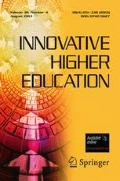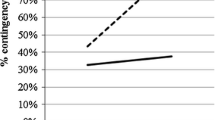Abstract
Experienced undergraduate students served as Peer Learning Assistants (PLAs) to facilitate group process and dynamics in cooperative learning groups. The use of this model in large classes (150 students) resulted in statistically significant improvements in group performance and satisfaction with the group experience. PLAs defused conflict in groups which were, by their cognitively diverse nature, conflict-prone. Student attitudes about their PLAs and PLA attitudes about the experience were positive. Faculty productivity was substantially enhanced because group dynamics problems rarely landed in the faculty office.
Similar content being viewed by others
References
Annis, L. F. (1983). The processes and effects of peer tutoring.Human Learning 2: 39–47.
Brooklyn College. (1991). Peer tutoring. In-house brochure.
Bruffee, K. A. (1978). The Brooklyn Plan: Attaining intellectual growth through peer-group tutoring.Liberal Education, 64:447–468.
Diamond, M. J. (1972). Improving the undergraduate lecture class by use of studentled discussion groups.American Psychologist, 27:978–981.
Egerton, J. (1978). Teaching learning while learning to teach. InGuide to Effective Teaching. New York: Change Magazine Press.
Fantuzzo, J. W., Riggio, R. E., Connelly, S., & Dimeff, L. A.. (1989). Effects of reciprocal peer tutoring on academic achievement and psychological adjustment: A component analysis.Journal of Educational Psychology, 81:173–177.
Goodwin, L., Miller, J. E., & Cheetham, R. D. (1991). Teaching freshmen to think: Does active learning work?BioScience, 41:719–722.
Janssen, P. (1978). Undergraduate TAs: Motivated and well prepared. InGuide to Effective Teaching. New York: Change Magazine Press.
Kail, H., & Trimbur, J. (1987). The politics of peer tutoring.WPA: Writing Program Administration, 11:5–12.
Kohn, A., & Brill, M. (1981). An introductory demonstration laboratory produced entirely by undergraduates.Teaching of Psychology, 8:133–138.
Lincoln, C. E. (1978). Students as facilitators. InGuide to Effective Teaching. New York: Change Magazine Press.
Magolda, M. B., & Rogers, J. L. (1987). Peer tutoring: Collaborating to enhance intellectual development.The College Student Journal, 21:288–296.
Miller, J. E., & Cheetham, R. D. (1990). Teaching freshmen to think: Active learning in introductory biology.BioScience, 40:388–391.
Miller, J. E., Wilkes, J. M., & Cheetham, R. D. (1993). Tradeoffs in student satisfaction: Is the “perfect” course an illusion?Journal on Excellence in College Teaching, 4:27–47.
Reitz, N., & McCuen, S. (1993). American Rivers College Beacon Project Student Catalyst Program: Peer assisted learning. Annual report, 1992–93. ERIC:ED365383.
Romer, K. T. (1988). Can undergraduates serve in the classroom?George St. Journal, 12:8.
Sugnet, C. J. (1978). The power of a supportive environment. InGuide to Effective Teaching. New York: Change Magazine Press.
Trimbur, J. (1987). Peer tutoring: A contradiction in terms?The Writing Center Journal, VII: 21–28.
White, K. M., & Kolber, R. G. (1978). Undergraduate and graduate students as discussion section leaders.Teaching of Psychology, 5:6–9.
Whitman, N. A. (1988).Peer Teaching: To teach is to learn twice. ASHE-ERIC Higher Education Report No. 4. Washington, D. C.: Association for the Study of Higher Education.
Wilcox, F. K. (1994). Encouraging Students to Read and Get Excited About Reading. In S. Kadel & J. A. Keehner (Eds.),Collaborative Learning: A Sourcebook for Higher Education, Vol. II (pp. 117–118). University Park, Pennsylvania: National Center on Postsecondary Teaching, Learning, and Assessment.
Additional information
James E. Groccia is the Director of the Program for Excellence in Teaching at the University of Missouri, Columbia. He received the Ed.D. in Educational and Counseling Psychology from the University of Tennessee, Knoxville, the Ms.Ed. in Social Science Education from Hofstra University, and the B.A. in Psychology from Hartwick College. Judith E. Miller is Associate Professor of Biology and Biotechnology at Worcester Polytechnic Institute, Worcester, Massachusetts. She received the Ph.D. in Microbiology from Case Western Reserve University and the B.S. in Biological Sciences from Cornell University. Her special interests include the restructuring of technical courses to include cooperative learning and educational productivity.
Rights and permissions
About this article
Cite this article
Groccia, J.E., Miller, J.E. Collegiality in the classroom: The use of Peer Learning Assistants in cooperative learning in introductory biology. Innov High Educ 21, 87–100 (1996). https://doi.org/10.1007/BF01243700
Issue Date:
DOI: https://doi.org/10.1007/BF01243700




